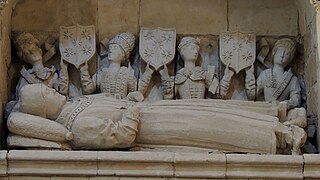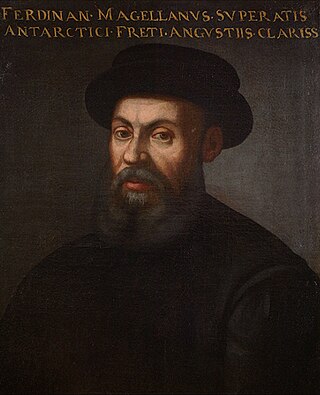
Marco Polo was a Venetian merchant, explorer and writer who travelled through Asia along the Silk Road between 1271 and 1295. His travels are recorded in The Travels of Marco Polo, a book that described to Europeans the then-mysterious culture and inner workings of the Eastern world, including the wealth and great size of the Mongol Empire and China under the Yuan dynasty, giving their first comprehensive look into China, Persia, India, Japan, and other locations throughout Asia.

Homonhon Island is an island in the province of Eastern Samar, Philippines, on the east side of Leyte Gulf. The 20-kilometre (12 mi) long island is part of the municipality of Guiuan, encompassing eight barangays: Bitaugan, Cagusu-an, Canawayon, Casuguran, Culasi, Habag, Inapulangan, and Pagbabangnan.

Enrique of Malacca, was a Malay member of the Magellan expedition that completed the first circumnavigation of the world in 1519–1522. He was acquired as a slave by the Portuguese explorer Ferdinand Magellan in 1511 at the age of 14 years, probably in the early stages of the capture of Malacca. Although Magellan's will calls him "a native of Malacca", Antonio Pigafetta states that he was a native of Sumatra. Magellan later took him to Europe, where he accompanied the circumnavigation expedition in 1519. According to some historians, it is possible that he could be the first person to circumnavigate the globe and return to his starting point, however, there is no record or source that confirms it.

Antonio Pigafetta was a Venetian scholar and explorer. He joined the Spanish expedition to the Spice Islands led by Portuguese explorer Ferdinand Magellan, the world's first circumnavigation, and is best known for being the chronicler of the voyage. During the expedition, he served as Magellan's assistant until Magellan's death in the Philippine Islands, and kept an accurate journal, which later assisted him in translating the Cebuano language. It is the first recorded document concerning the language.

Victoria or Nao Victoria was a carrack famed as the first ship to successfully circumnavigate the world. Victoria was part of the Spanish expedition to the Moluccas commanded by the explorer Ferdinand Magellan.

Juan Rodríguez de Fonseca (1451–1524) was a Spanish archbishop, a courtier and bureaucrat, whose position as royal chaplain to Queen Isabella enabled him to become a powerful counsellor to Ferdinand and Isabella, the Catholic Monarchs. He controlled the Casa de Contratación, an agency which managed expeditions to the New World on behalf of the Spanish crown. He later served as the president of the Council of the Indies, when it was founded in 1521. He managed the administration of a number of significant Spanish expeditions including voyages by Christopher Columbus and Magellan's circumnavigation of the earth.
Cristóbal de Haro was a Castilian financier and merchant from Burgos, famous for having provided funding for the Magellan-Elcano expedition.
Rui (Ruy) Faleiro, also known as Ruy de Faleira, was a Portuguese cosmographer, astrologer, and astronomer who was the principal scientific organizer behind Ferdinand Magellan's circumnavigation of the world.

Estêvão Gomes, also known by the Spanish version of his name Esteban Gómez, was a Portuguese explorer. He sailed in the service of Castile (Spain) in the fleet of Ferdinand Magellan, but deserted the expedition when they had reached the Strait of Magellan and returned to Spain in May 1521. In 1524, he explored the coast of present-day New England and Nova Scotia. As a result of Gomes' expedition, cartographer Diogo Ribeiro was the first to accurately portray North America with a continuous coastline stretching from Florida to Nova Scotia.

The Magellan expedition, sometimes called the Magellan-Elcano expedition, was an early 16th-century Spanish expedition planned and led by Portuguese explorer Ferdinand Magellan with the objective of crossing the Atlantic and Pacific oceans in order to open a trade route with the Moluccas. The expedition departed from Spain in 1519 and returned there in 1522, completed by the Spanish navigator Juan Sebastián Elcano, who crossed the Indian ocean after Magellan's death in the Philippines, thus culminating in the first circumnavigation of the world.

Ferdinand Magellan was a Portuguese explorer best known for having planned and led the 1519 Spanish expedition to the East Indies across the Pacific Ocean to open a maritime trade route, during which he discovered the interoceanic passage thereafter bearing his name and achieved the first European navigation to Asia via the Pacific. After his death, this expedition was the first to circumnavigate the globe in 1519–22 in the service of Spain.
Francisco Combés, SJ was a Spanish Jesuit priest who established Christian monasteries in the Philippines in the 17th century.
Trinidad was the flagship of Ferdinand Magellan's voyage of circumnavigation. Unlike Elcano's Victoria, which returned to Spain sailing across the Indian Ocean, Trinidad tried and failed to sail east across the Pacific to New Spain or modern-day Mexico. Trinidad was a nao (ship) of 100 or 110 tonels with square sails on the fore and main masts and a lateen mizzen. Its original crew was 61. After Magellan's death and the burning of the Concepcion, Victoria and Trinidad reached Tidore on 8 November 1521. In mid-December both ships attempted to depart loaded with cloves, but Trinidad almost immediately began to leak badly. Inspection showed that the problem was serious. It was agreed that Victoria would leave for Spain and Trinidad would remain for repairs.

The Magellan expedition was the first voyage around the world in human history. It was a Spanish expedition that sailed from Seville in 1519 under the initial command of Ferdinand Magellan, a Portuguese sailor, and completed in 1522 by Spanish Basque navigator Juan Sebastián Elcano.
Vice-Admiral Sir John Wynter or Winter (1555–1638) was an explorer and naval officer in the English Navy Royal. As a ship's captain in the Drake expedition of 1577-1580, he was the first European to cross the Strait of Magellan from west to east.

Over the Edge of the World: Magellan's Terrifying Circumnavigation of the Globe is a book written by biographer Laurence Bergreen, first published by William Morrow and Company in 2003.
Gaspar de Quesada was a Spanish explorer who participated in Magellan's circumnavigation as captain of the Concepción, one of the expedition's five ships. Approximately six months in to the expedition, Quesada, with two other Spanish captains, attempted to overthrow Magellan in the Easter mutiny at the South American port of St. Julian. The mutiny failed and Magellan had Quesada executed.

Luis de Mendoza was a Spanish mariner and explorer.
This timeline of time measurement inventions is a chronological list of particularly important or significant technological inventions relating to timekeeping devices and their inventors, where known.
Fantina Polo was a noblewoman of the Republic of Venice.












